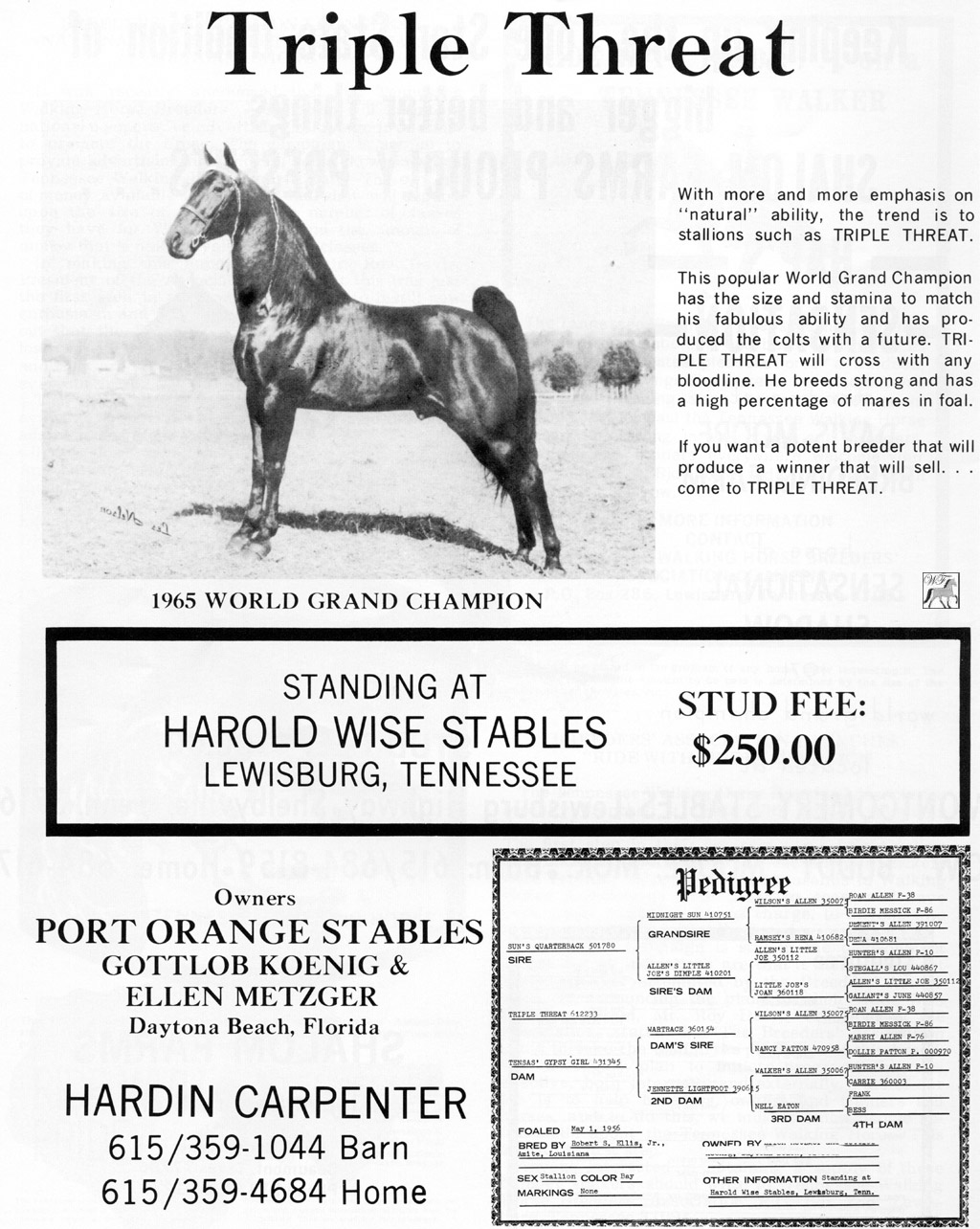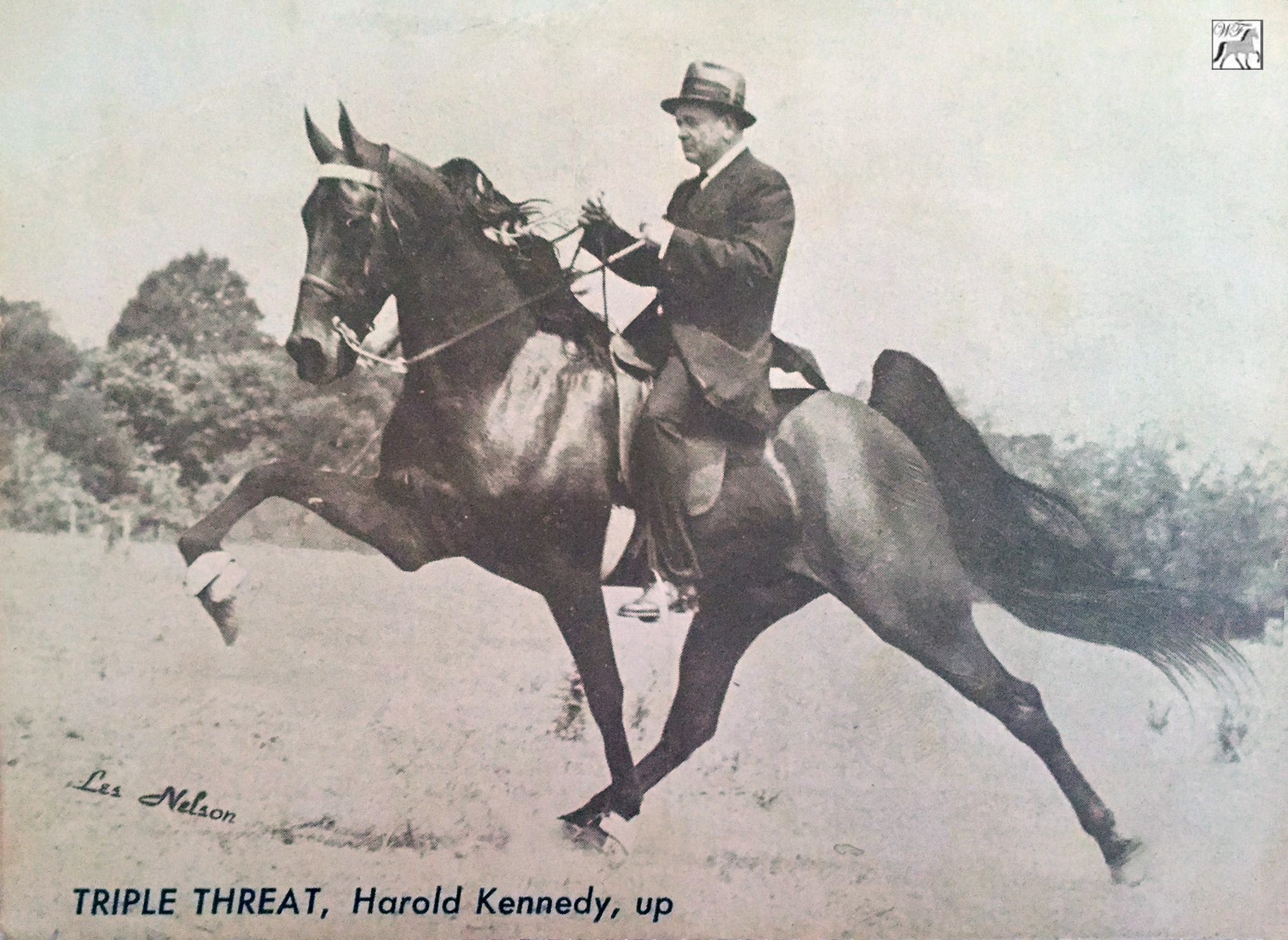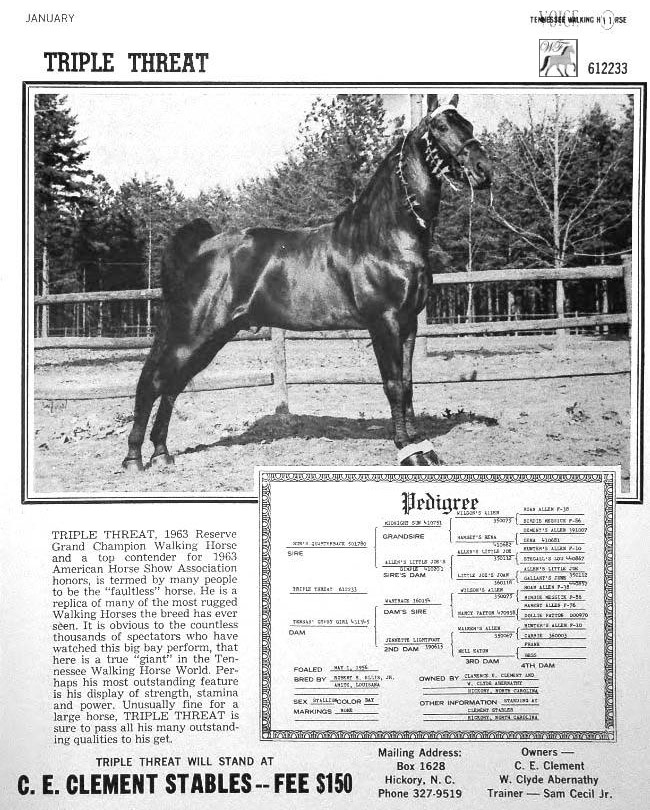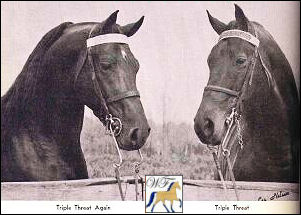Some horses, like some people, are always late. The story
of TRIPLE THREAT, 1965 World Grand Champion Tennessee Walking
Horse, now standing at stud in Kentucky, is a good example.
Everything that ever happened to him was late. He was a
late colt. He was not registered until 1961, five years
after he was born. He did not get any consistent training
under saddle until he was a five-year-old. He did not win
the Celebration until 1965, after trying three times.
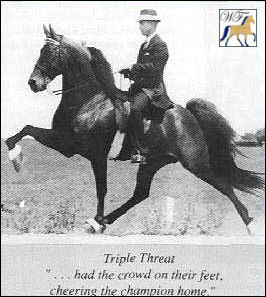
His
ability as a breeding stallion was not recognized until
almost five years after he was retired.
In spite of the
fact that he was always a little behind schedule, TRIPLE
THREAT always attracted the attention and acclaim of knowledgeable
horsemen. His breeding, size, natural walking ability, conformation
and many other attributes prompted no less than a dozen
owners to invest in him over the years. The amount these
people were willing to invest ranged from $1,200 when he
was a youngster to more than $100,000 shortly after he won
the Celebration. Along the way he becamet he object of much
discussion and brought $43,000 at the Murray Farm Sale in
the spring of 1965. It is estimated that in his eighteen
years, more than a quarter of a millon dollars has changed
hands along with the pedigree and ownership rights to TRIPLE
THREAT. He might have been a "day late...but he was
never a dollar short!"
TRIPLE THREAT was originally
owned by Robert S. Ellis of Amite, Louisana. He was foaled
May 1, 1956 and was out of a fine mare named TENSA'S GYPSY
GIRL and by a popular stallion named
SUN'S QUARTERBACK.
It was a perfect blend of foundation blood that produced
a unique specimen of the Tennessee Walking Horse. He was
purchased as a yearling by Gaynell "Gus" Tensley,
former football coach and All American at LSU.
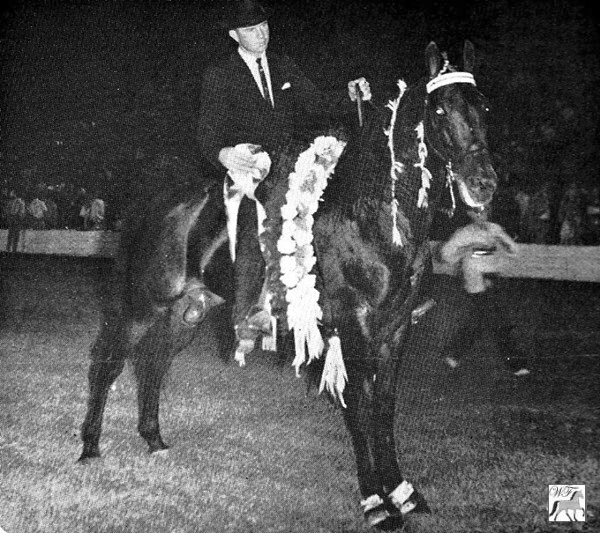
It
was not until his transaction that TRIPLE THREAT was registered.
He was then a five-year-old and no one really knew much
about his background.
It is said that hew as broke to
ride by Digby Palmer, who was then working horses in Amite,
Louisiana, but was never trained for showring activity as
a young horse. One story says that he hurt his leg and was
turned out to pasture and virtually forgotten for several
years. The first time he was shown was in 2961 and he won
the blue at Nacogdoches, Texas with Gus Tensley in the saddle.
At this point he began to attract some attention and was
purchased by J. Glen Turner of Dallas, Texas. Harold Kennedy
was head trainer at the Circle T Ranch of the Turners' and
was quickly attracted to the big-lick bay stallion.
At this point the fortune of Circle T Ranch was on the rise.
They had purchased some top horses and were very active
in both open an amateur competition.
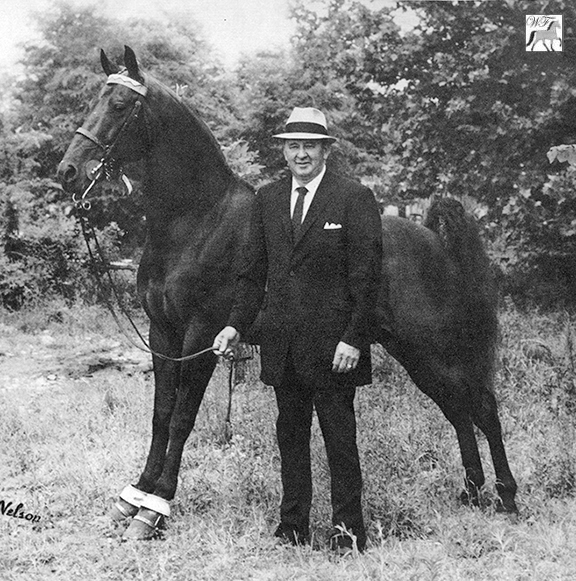
Harold
Kennedy was at the top of the heap as far as training was
concerned. His stock was winning and they were "Celebration
bound" in 1962. TRIPLE THREAT was originally scheduled
to be shown by Mr. Turner in the amateur class but this
was changed at the last minute and Harold Kennedy showed
this unknown bay stallion to tie fourth in the stallion
class and fifth in the big stake. At this point, the showring
career of TRIPLE THREAT was launched in earnest.
Nineteen
sixty-three was to be an ambitious year for both Harold
Kennedy and TRIPLE THREAT. They would travel over sixteen
thousand miles frm the Florida circuit throughout the southwest
and on into Tennessee prior to the Celebration. TRIPLE THREAT
became the leading contender in everybody's book as he mowed
down on opponent after another. The elusive crown was to
be denied in 1963, however, as
SUN'S DELIGHT
won the title with Same Paschal in the saddle. The next
season was to be more of the same as the popular contender
was again tied reserve. This time to
CARBON COPY,
with Joe Webb up.
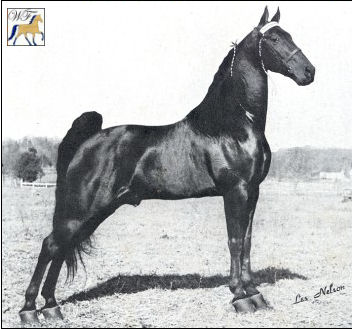
The
1964 trip was made under new ownership, however, as Mr.
Turner had sold all of his horses and literally "got
out of the business" after the Celebration the
previous year. Most of his stock was purchased in a package
by Pat Kimbrough of Murphreesboro, Tennessee, and TRIPLE
THREAT was eventually sold in the spring of 1964 to a trio
of Carolina horsemen. Abernathy, Clement and Sherill become
the proud owners of the nation's number one contender and
once again launched a campaign toward the world title. He
was worked through the early season by a trainer named Sam
Cecil, who was then working at the Clement Stables in Hickory,
North Carolina. As the mid-season approached, they decided
to put him back in training with the man who knew him best
- Harold Kennedy.
After his defeat in 1964, TRIPLE THREAT
became the object of much discussion. His owners decided
to sell him at the spring Murray Farm Sale in 1965 and with
trainer Buddy Black in the saddle, he topped all records
with a bid of $43,000. He became the property, if only briefly,
of Hank Sheely of Dallas, Texas. Shortly after the sale
he was purchased by Joe Wright of Nacogdoches, Texas and
put with Steve Hill in Beech Grove, Tennessee. Steve showed
him successfully at the Manchester, Tennessee show and proved
to many onlookers that the big bay was still a contender.
Shortly after this, it was announced that he would be put
in training with Douglas Wolaver of Cornersville, Tennessee
in preparation for the 1965 Celebration.
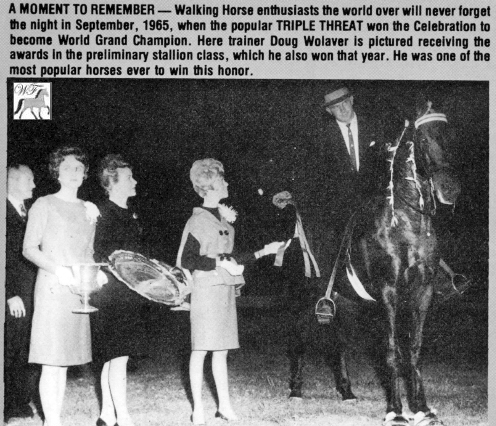
The
record books now show that this was to be the year. Doug
carried TRIPLE THREAT to the Celebration arena undefeated.
His performance was superb and it was the "Wolaver
touch" that appearantly made the difference. He became
the 1965 World Grand Champion and was retired to stand stud
at the Harold Wise Stables in Lewisburg. Once again, the
attraction of TRIPLE THREAT prompted men to part with their
money and he became the object of a three-way partnership
as Bob Guinn of Savannah, Tn. and Al Kroesche of San Antonio,
Texas purchased two-thirds of the new champion.
In June
of 1966, after getting off to a fine first season as a major
breeding stallion, TRIPLE THREAT was sold to Ellen Metzger
and Gotlob Koenig of Port Orange, Florida. The price was
reported to be in excess of $100,000 and supposedly the
highest price ever paid for a Tennessee Walking Horse at
that time.
For the next five seasons TRIPLE THREAT was
the feature attraction of the WIse Stables. His stable-mate
was this own sire,
SUN'S QUARTERBACK. As the seasons passed,
the get of TRIPLE THREAT made substantial progress in the
showring, but it was obvious that something was missing.
For some reason they just couldn't seem to fit the pattern
that was established for the breed at that time. He was
bred to a lot of mares in those five years, however, and
produced a lot of fine colts.
The problem appeared to
be that most of these colts were somewhat like their sire.
They really didn't come on until they got some age and some
size. As yearlings, they did not possess the qualities that
one looks for in a halter colt, although some did well in
this category. As two-year-olds, they were big and rangy...lacking
the capability to "make in a hurry" and compete
with others their age.
But...as time passed it became
apparant that more and more TRIPLE THREAT horses were arriving
to the top. They were the three-year-olds, junior horses
and aged horses that were late comers as youngsters. As
many of the fancy two-year-olds by other stallions dropped
by the wayside and were never heard from again, the colts
by TRIPLE THREAT kept getting better and better. The trends
of the breed gradually changed and the "sound"
horse became a necessity and TRIPLE THREAT horses appeared
to come out of the woodwork. Soon, TRIPLE THREAT was once
again attracting attention as the Walking Horse world became
aware of the potential of his colts.
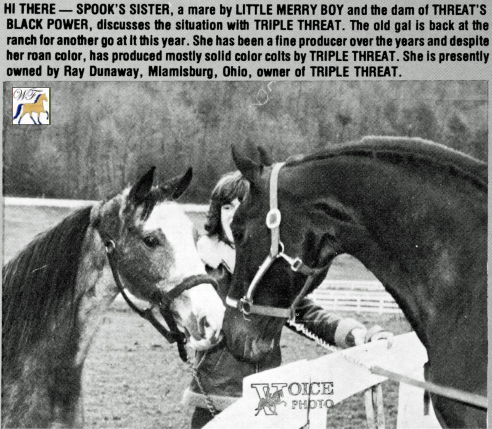
In
May of 1972, TRIPLE THREAT once again became the object
of a major transaction in the Walking Horse business. He
was purchased by Mr. Ray Dunaway of Miamisburg, Ohio and
was immediately moved to Van Bert Farms in Stanton, Kentucky
to be managed by H.T. Derickson. His first season at stud
in Kentucky was most successful. They topped all previous
seasons for the number of mares bred and his new owner went
all-out to promote his stallion and his colts. Horsemen
from middle Tennessee were making regular trips from the
center of activity to Kentucky to breed to the 1965 champion.
He was getting better and better mares and a high percentage
of them in foal. 1973 proved to be even more successful
and at last it looked as if TRIPLE THREAT was finally on
the way as a stud.
A dramatic peak was reached at the
1973 Celebration that catapulted TRIPLE THREAT into the
spotlight once again. The three-year-old championship was
won by THREAT'S BLACK POWER with trainer Bill Bailey in
the saddle for owner Ray
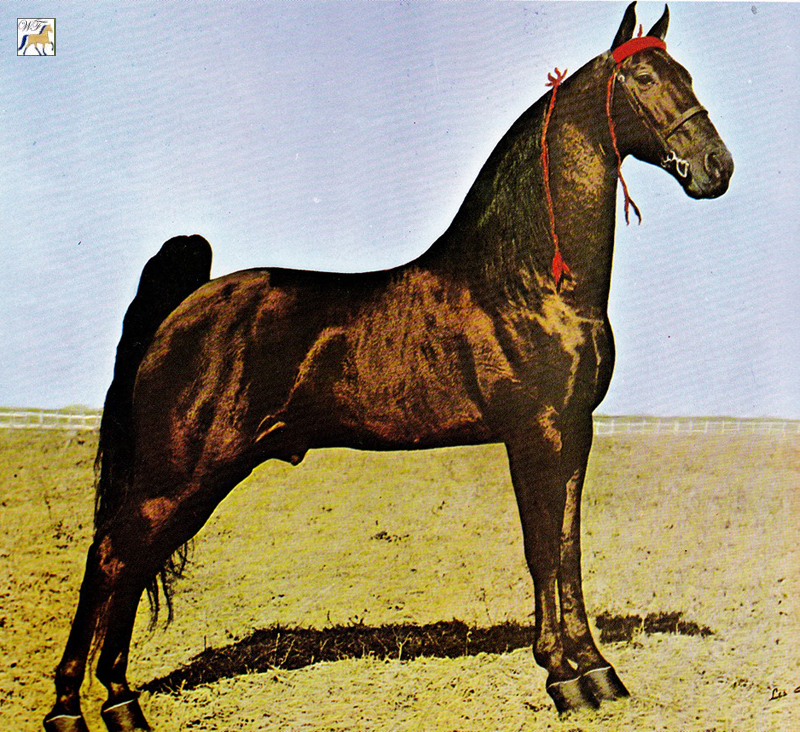
Dunaway. This horse was considered
one of the top performers ever seen at the Celebration and
it climaxed a season that saw many horses by TRIPLE THREAT
go to the winner's circle. The recent sale of THREAT'S BLACK
POWER for a record high price also helped the career of
his sire as more and more mare owners are making their bookings
early for the big bay stallion.
Another major change
recently took place as owner Dunaway announced that his
popular stallion would stand in the 1974 season at
the Herb Roberts Stables in South Irvine, Kentucky. The
move was prompted by a lease agreement arrived at between
Dunaway and Roberts. TRIPLE THREAT is now on a five year
contract to Roberts Stables, and will continue to stand
there throughout his contract.
A recent visit to Roberts
Stables indicates that 1974 will be the best year ever for
TRIPLE THREAT. His popularity is on the upswing and the
horsemen of Kentucky are appreantly taking a great deal
of pride in the fact that TRIPLE THREAT is now in their
state. Many people have purchased mares in the last year
for the expressed purpose of breeding to THREAT and an even
larger number of mares from Tennessee are scheduled to make
the trip to his court.
As the 1974 show season gets
underway, the momentum of TRIPLE THREAT's new popularity
will begin to be felt. More and more horses with the "THREAT"
label will be in the showring and they should be top winners.
The price of his colts should upswing as the natural lick
becomes more dominant.
An investment in a THREAT colt
at this time could very well be the best investment that
a horseman could make. After all...he may have been "a
day late...but he was never a dollar short!"

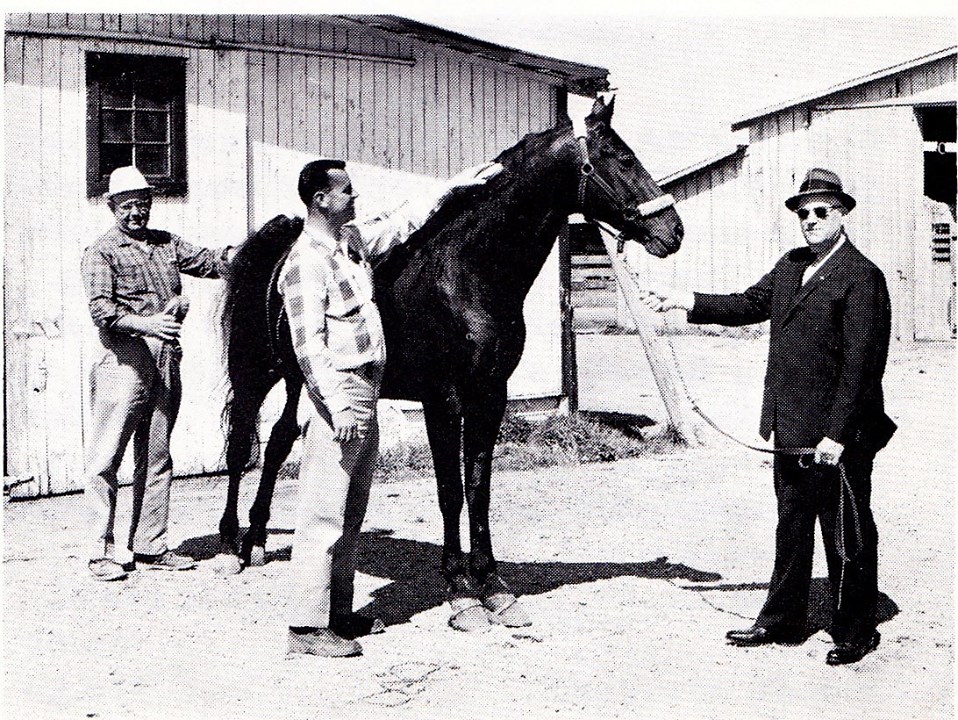
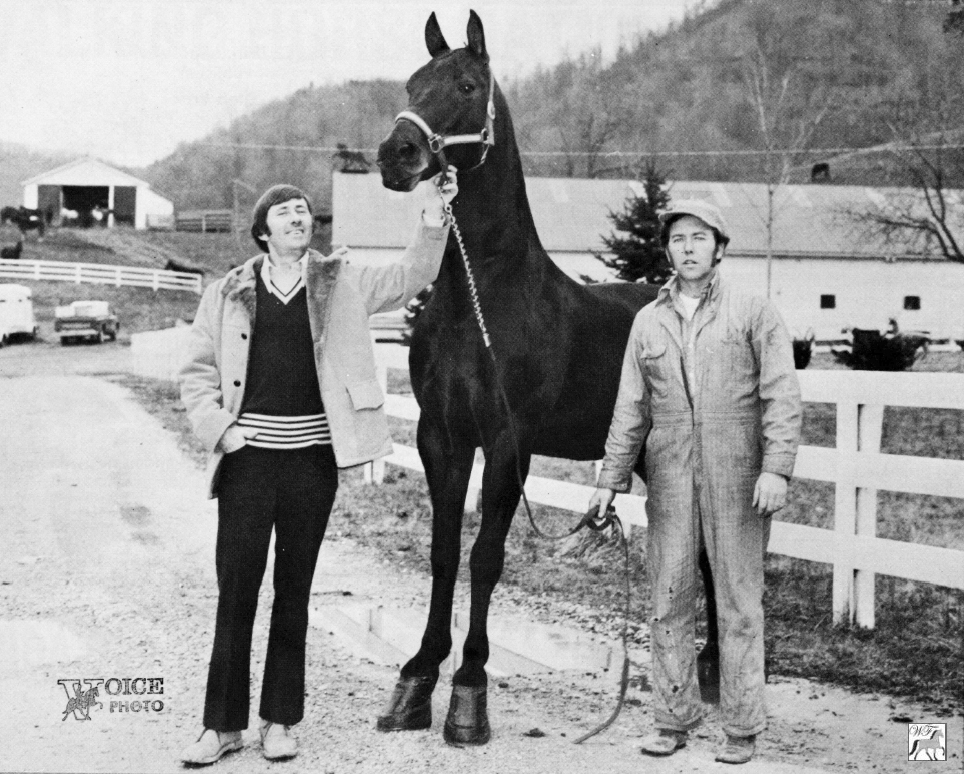




 The
record books now show that this was to be the year. Doug
carried TRIPLE THREAT to the Celebration arena undefeated.
His performance was superb and it was the "Wolaver
touch" that appearantly made the difference. He became
the 1965 World Grand Champion and was retired to stand stud
at the Harold Wise Stables in Lewisburg. Once again, the
attraction of TRIPLE THREAT prompted men to part with their
money and he became the object of a three-way partnership
as Bob Guinn of Savannah, Tn. and Al Kroesche of San Antonio,
Texas purchased two-thirds of the new champion.
The
record books now show that this was to be the year. Doug
carried TRIPLE THREAT to the Celebration arena undefeated.
His performance was superb and it was the "Wolaver
touch" that appearantly made the difference. He became
the 1965 World Grand Champion and was retired to stand stud
at the Harold Wise Stables in Lewisburg. Once again, the
attraction of TRIPLE THREAT prompted men to part with their
money and he became the object of a three-way partnership
as Bob Guinn of Savannah, Tn. and Al Kroesche of San Antonio,
Texas purchased two-thirds of the new champion.  In
May of 1972, TRIPLE THREAT once again became the object
of a major transaction in the Walking Horse business. He
was purchased by Mr. Ray Dunaway of Miamisburg, Ohio and
was immediately moved to Van Bert Farms in Stanton, Kentucky
to be managed by H.T. Derickson. His first season at stud
in Kentucky was most successful. They topped all previous
seasons for the number of mares bred and his new owner went
all-out to promote his stallion and his colts. Horsemen
from middle Tennessee were making regular trips from the
center of activity to Kentucky to breed to the 1965 champion.
He was getting better and better mares and a high percentage
of them in foal. 1973 proved to be even more successful
and at last it looked as if TRIPLE THREAT was finally on
the way as a stud.
In
May of 1972, TRIPLE THREAT once again became the object
of a major transaction in the Walking Horse business. He
was purchased by Mr. Ray Dunaway of Miamisburg, Ohio and
was immediately moved to Van Bert Farms in Stanton, Kentucky
to be managed by H.T. Derickson. His first season at stud
in Kentucky was most successful. They topped all previous
seasons for the number of mares bred and his new owner went
all-out to promote his stallion and his colts. Horsemen
from middle Tennessee were making regular trips from the
center of activity to Kentucky to breed to the 1965 champion.
He was getting better and better mares and a high percentage
of them in foal. 1973 proved to be even more successful
and at last it looked as if TRIPLE THREAT was finally on
the way as a stud. Dunaway. This horse was considered
one of the top performers ever seen at the Celebration and
it climaxed a season that saw many horses by TRIPLE THREAT
go to the winner's circle. The recent sale of THREAT'S BLACK
POWER for a record high price also helped the career of
his sire as more and more mare owners are making their bookings
early for the big bay stallion.
Dunaway. This horse was considered
one of the top performers ever seen at the Celebration and
it climaxed a season that saw many horses by TRIPLE THREAT
go to the winner's circle. The recent sale of THREAT'S BLACK
POWER for a record high price also helped the career of
his sire as more and more mare owners are making their bookings
early for the big bay stallion. 